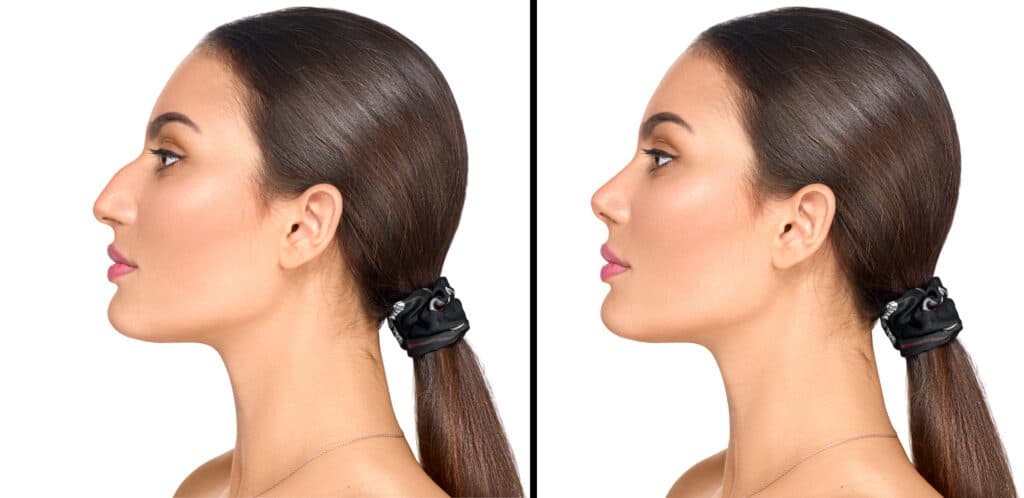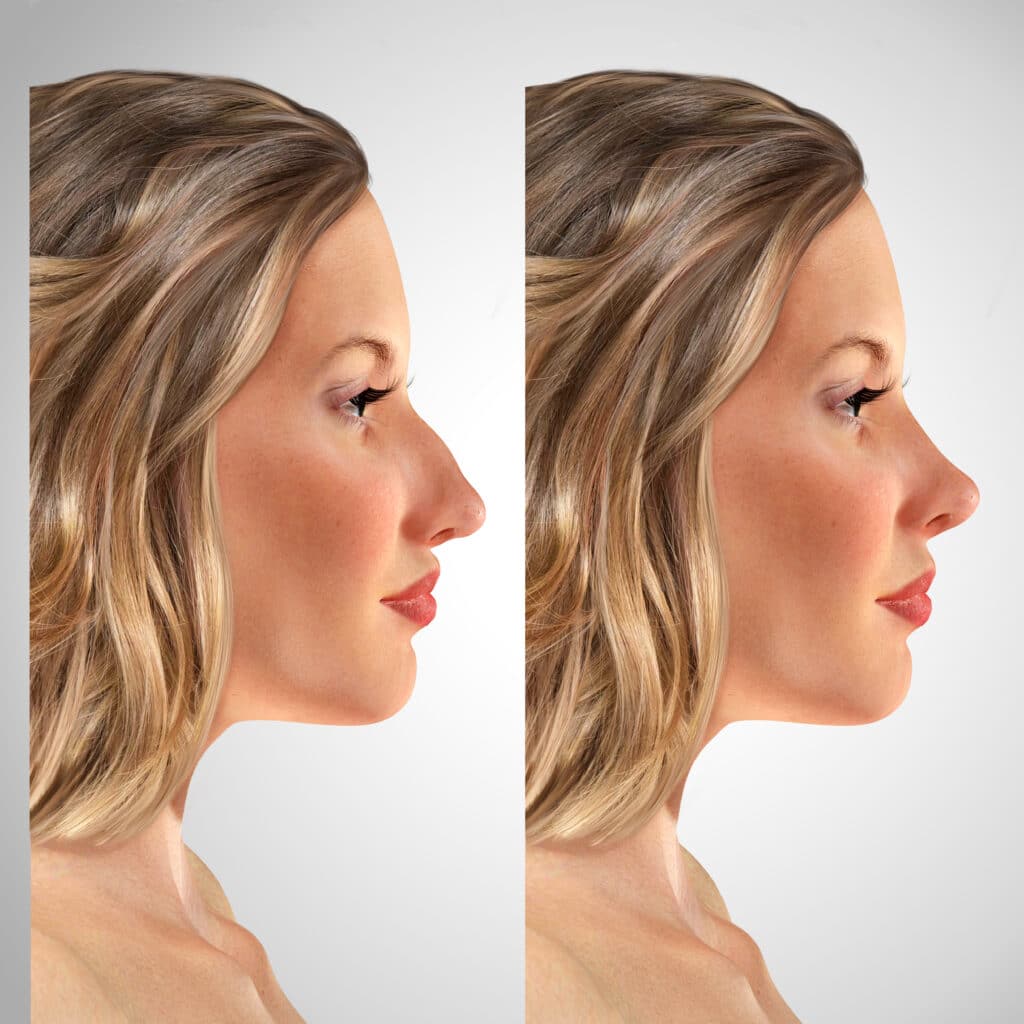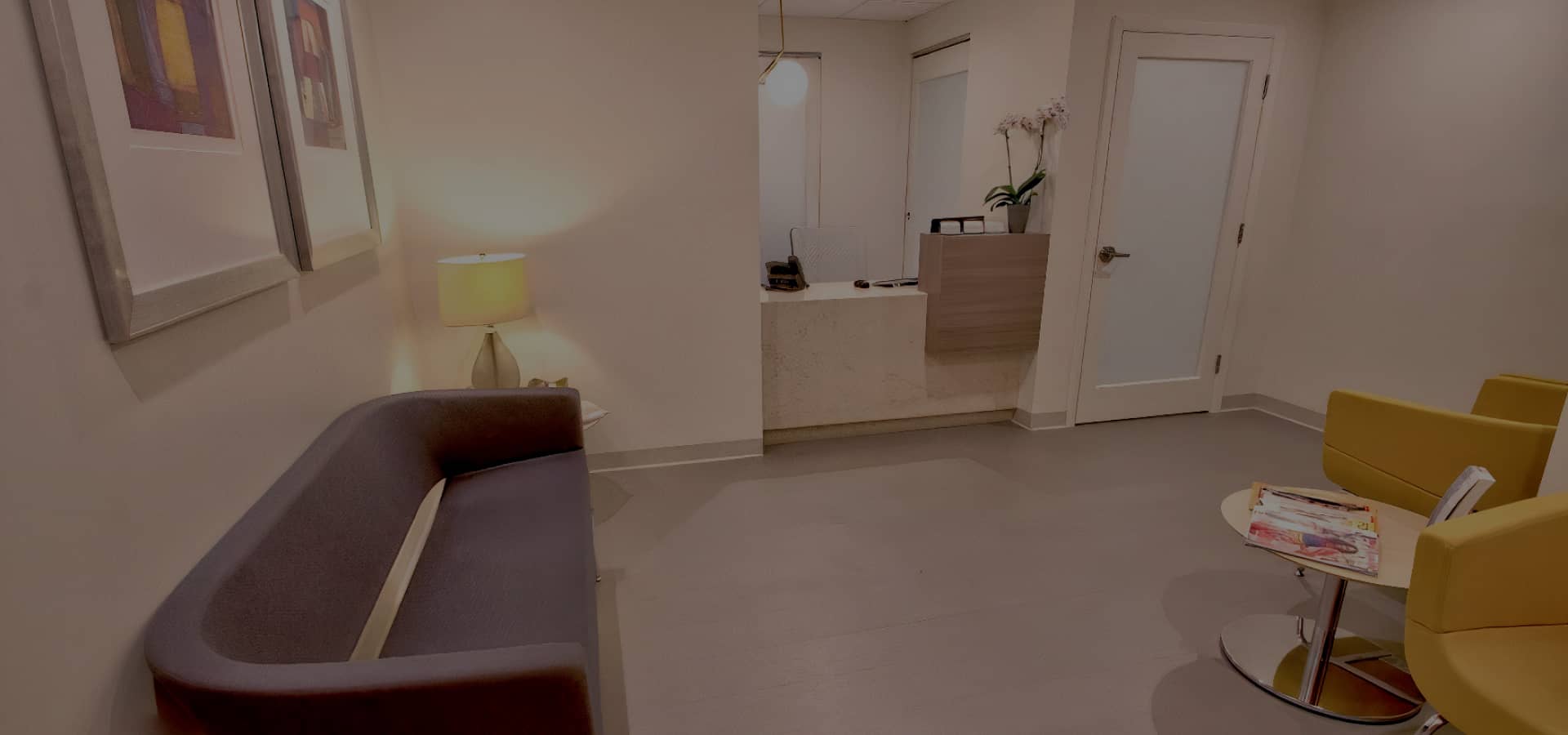What Is a Dorsal Hump?
A dorsal hump is a protrusion found on the bridge of the nose, resulting from enlarged lateral cartilage, excessive bone or cartilage on the nasal dorsum, or a combination of these factors. This deformity can affect the external and internal nasal valves and disrupt the aesthetic lines of the nose.
Trauma to the nasal bridge can cause dorsal humps, or they may occur due to an inherited trait. Some people are predisposed to having a dorsal hump due to genetics, while others may develop one over time from aging or sun damage to their skin. Regardless of the cause, some patients may feel self-conscious and uncomfortable about their appearance with this type of facial deformity.
Fortunately, treatments can help reduce or even eliminate a dorsal hump. The most common treatment for this condition is called rhinoplasty surgery (also known as a “nose job”). During this procedure, your surgeon will reshape your nose by removing any excess tissue or bone that is causing your hump. They may also reposition any affected cartilage to create a smoother contour along your nasal bridge. After surgery, you should notice an improved aesthetic look with your new nose shape, free from any visible bumps or humps.
If you’re considering surgery to reduce your dorsal hump in Miami, then you should contact Dr. Anthony Bared, M.D., an expert plastic surgeon in Miami who specializes in rhinoplasty surgery for correcting facial deformities. He offers customized solutions tailored specifically for each patient to ensure optimal results and satisfaction at every stage of treatment!
Causes of a Dorsal Hump
Genetic Predisposition
Genetic Predisposition is one of the leading causes of a dorsal hump. Genetic abnormalities can affect the nasal bones, the cartilaginous hump, and the dorsal septum. This may cause the nose to be abnormally structured, which can result in a bump or hump on the nose bridge.
The most common type of nasal deformity is a cartilaginous hump. This occurs when extra cartilage in the area of the nasal bridge causes it to appear higher than normal. This can be caused by an abnormally large nasal bone or septum, as well as excessive amounts of cartilage present in that area.
Additionally, genetics can also affect the shape and size of other parts of the nose such as the tip and nostrils, further contributing to a dorsal hump. Those with a family history of dorsal humps should seek out professional assistance if they are considering rhinoplasty surgery for correcting this facial deformity.
Aging Process
Aging can lead to a dorsal hump because the nasal skin things with age. This can cause the underlying bony humps to become more prominent and visible externally, resulting in a bump on the nose bridge. Providers often recommend rhinoplasty surgery for those looking to reduce their dorsal hump because this surgical technique can effectively correct this type of facial deformity. During rhinoplasty surgery, the surgeon will carefully reshape the nasal dorsum and remove any excess bone or cartilage to create a smoother contour along your nasal bridge. In some cases, the surgeon may even adjust the position of your nasal dorsal spine to improve airflow through your nose, reducing your discomfort from having a dorsal hump. Your surgeon will then use sutures or other techniques to further refine your new shape and ensure optimal results that will leave you with a more aesthetically pleasing appearance!
Birth Defects
Birth defects can cause a dorsal hump due to an abnormality in the middle nasal vault or septal cartilage. An individual born with this type of defect will typically have an enlarged nasal structure, as well as excess cartilage on the bridge of their nose, that can cause a visible hump. patients looking to reduce or eliminate their dorsal hump can choose from several surgical approaches depending on the individual’s specific case and the severity of their condition. Some procedures may involve reshaping and repositioning the nasal dorsum, removing any excess bone or cartilage, and refining the shape of the nose using sutures or other techniques. In more severe cases, the surgeon may be able to adjust the position of your nasal dorsal spine to improve airflow through your nose, reducing your discomfort from the dorsal hump.

Symptoms of a Dorsal Hump
This deformity typically occurs when there is an abnormality in the septal angle or cartilaginous septum, resulting in an overly prominent nasal shape. In some cases, the nose may appear crooked or misshapen. While genetics can play a role in causing this deformity, it can also be caused by injuries or the aging process. For those looking to reduce their dorsal hump, your provider may recommend rhinoplasty as it effectively correct this facial deformity and restore balance to your facial features. During rhinoplasty surgery, your surgeon will carefully reshape your nasal dorsum and remove any excess bone or cartilage to create a smoother contour along your nasal bridge. The surgeon may also be able to adjust the position of your nasal septum and refine your new shape using sutures or other techniques. This will ensure optimal results and leave you with a more aesthetically pleasing appearance.

Unnatural Aesthetic Appearance of the Nose
Many patients desire to have their dorsal hump removed to achieve a more aesthetically pleasing appearance.
When you are considering a Miami rhinoplasty, one of the things your plastic surgeon will discuss with you is skin thickness. During this procedure, your plastic surgeon will carefully reshape the nasal dorsum and remove any excess bone or cartilage to create a smoother contour along your nasal bridge.
Depending on the severity of your condition and aesthetic goals, the surgeon may also adjust the position of your nasal septum and refine your new shape using sutures or other techniques for optimal results. By improving symmetry and balance in your profile, cosmetic rhinoplasty can effectively eliminate a dorsal hump for a more aesthetically natural look.
Breathing Difficulties Through the Nose
Difficulty breathing through the nose can be a symptom of a dorsal hump. Many individuals will experience nasal obstruction due to an abnormality in the septal angle or cartilaginous septum, resulting in an overly prominent nasal shape. Patients may seek out facial plastic surgeons that specialize in rhinoplasty surgery to reduce their dorsal hump. During this procedure, your surgeon will carefully reshape your nasal dorsum and remove any excess bone or cartilage to create a smoother contour along your nasal bridge. Depending on the severity of your condition and aesthetic goals, the surgeon may adjust the position of your nasal septum and refine your new shape using sutures or other techniques for optimal results. Recovery time from this procedure typically ranges from 1 week to 1 month, and you must follow all of your doctor’s post-operative instructions for best results. With proper treatment, many patients can achieve significant improvement in their breathing issues as well as improved facial symmetry with reduced or eliminated dorsal bumps for a more aesthetically natural-looking nose.
Sinus Congestion and Pressure
Sinus congestion and pressure can be symptoms of a dorsal hump, often caused by an abnormality in the septal angle or cartilaginous septum, resulting in an overly prominent nasal shape. Functional rhinoplasty is a form of plastic surgery that targets the structural abnormalities within the nose that cause these symptoms. During this type of procedure, your surgeon will carefully reshape your nasal dorsum and remove any excess bone or cartilage to create a smoother contour along your nasal bridge. Depending on the severity of your condition and aesthetic goals, the surgeon may adjust the position of your nasal septum and refine your new shape using sutures or other techniques for optimal results. In some cases, the surgeon may use cartilage grafts to further enhance the aesthetics and improve breathing difficulties associated with a dorsal hump. If you are looking for relief from sinus congestion and pressure due to a dorsal hump, you should consult with an experienced rhinoplasty surgeon who specializes in functional rhinoplasty to determine whether this type of procedure is right for you. With proper treatment, many patients can achieve significant improvement in their breathing issues as well as improved facial symmetry with reduced or eliminated dorsal bumps for a more aesthetically natural-looking nose.
Is Dorsal Hump Reduction a Procedure Included in Rhinoplasty?
Dorsal hump reduction is a common procedure included in rhinoplasty, aimed at fixing nasal deformities. By carefully removing or reshaping the excess bone and cartilage, this technique can effectively address the hump on the bridge of the nose, improving both aesthetics and function.
What Are the Risks of Bruising After Dorsal Hump Reduction Surgery?
Understanding post-rhinoplasty bruising is crucial for patients considering dorsal hump reduction surgery. While it is a common side effect, there are still risks associated with it. Excessive bruising can lead to prolonged healing time and potential complications. Therefore, proper pre-surgical assessment and following the surgeon’s aftercare instructions can minimize these risks.
Review of Dorsal Hump Reduction in Miami
Dorsal Hump Reduction Procedure
The dorsal hump reduction procedure is a surgical rhinoplasty technique that reduces the prominence of a dorsal hump, or an area of overgrowth along the bridge of the nose, for improved facial profile and aesthetic results. During this procedure, your plastic surgeon will carefully reshape the nasal dorsum by removing any excess bone or cartilage to create a smoother contour along your nasal bridge. Depending on the severity of your condition and desired outcome, the surgeon may also use spreader grafts to provide further support and refine your new shape using sutures or other techniques for optimal results. With proper treatment, many patients can achieve significant improvement in their facial profile with reduced or eliminated dorsal bumps for a more aesthetically natural look. In Miami, Dr. Anthony Bared is an expert in these types of procedures and can help you achieve desirable outcomes with his advanced techniques and expertise.


Preparation for the Procedure
When preparing for a dorsal hump reduction procedure, you should understand the aesthetic ideals that want with your refined nose. Every individual’s facial structure and anatomy are different, so you should discuss your goals and expectations with a qualified plastic surgeon who can help you determine if this type of surgery is right for you. Additionally, many surgeons will use before-and-after photographs of previous successful procedures to provide insight into the expected results and design a proportional nose that meets your aesthetic needs. After the initial consultation, your surgeon will provide instructions on how to properly prepare for the procedure, such as avoiding certain medications before surgery, abstaining from food or drink after midnight the night before surgery, and any other instructions specific to your case. Following all preoperative instructions closely can help ensure successful outcomes from your nose surgery

Understanding Post-Operative Care and Managing Risks in Dorsal Hump Reduction
After undergoing dorsal hump reduction, it’s crucial for patients to have a clear understanding of the post-operative care and potential risks associated with the procedure. This knowledge not only prepares patients for what to expect but also ensures a smoother recovery and optimal results.
Post-Operative Care:
- Immediate Aftercare: Immediately following surgery, patients may experience swelling and bruising around the nose and eyes. This is normal and typically subsides within the first few weeks.
- Rest and Recovery: Patients are advised to rest with their head elevated for the first few days post-surgery to reduce swelling. Strenuous activities should be avoided for at least 3-4 weeks.
- Follow-Up Visits: Scheduled follow-up visits are crucial for monitoring the healing process. These appointments allow for timely identification and management of any complications.
- Medication and Pain Management: Prescribed medications should be taken as directed to manage pain and prevent infection.
- Long-Term Care: Long-term care includes avoiding sun exposure and wearing sunscreen to protect the healing skin, as well as adhering to any specific instructions provided by the surgeon.
Managing Risks:
- Infection: While rare, infections can occur. Patients are provided with guidelines on how to keep the surgical area clean and may be prescribed antibiotics as a preventative measure.
- Scarring: Scarring is typically minimal and well-concealed. However, patients should follow care instructions to ensure proper healing and minimize scar visibility.
- Nasal Function: In some cases, changes to nasal structure during surgery can affect breathing. It’s important to discuss any concerns with your surgeon during follow-up visits.
- Aesthetic Concerns: Occasionally, revisions may be necessary if the aesthetic outcome does not meet the patient’s expectations. Open communication with the surgeon is key to addressing these concerns.
Frequently Asked Questions about Dorsal Hump Reduction
A dorsal hump is a noticeable bump on the bridge of the nose, often a mix of bone and cartilage. It can be a genetic trait or develop due to injury or other factors.
If you’re self-conscious about the appearance of your nose or experiencing breathing issues due to a dorsal hump, this procedure might be suitable. A consultation with a qualified surgeon is essential to determine your candidacy.
The surgery typically involves reshaping the nasal bones and cartilage to achieve a smoother nasal profile. Techniques vary depending on the individual case.
Recovery may involve swelling, bruising, and discomfort for a few weeks. Most patients return to normal activities within 2-3 weeks, but complete healing can take longer.
As with any surgery, there are risks such as infection, bleeding, or dissatisfaction with the results. Choosing a skilled and experienced surgeon minimizes these risks.
While initial changes are noticeable immediately, the final shape of your nose may take up to a year to fully settle.
If the surgery is purely cosmetic, it’s unlikely to be covered by insurance. However, if it’s necessary for functional reasons, like improving breathing, partial coverage is possible.
Yes, it’s often combined with other nasal surgeries like septoplasty for functional improvements or with other cosmetic procedures for enhanced facial harmony.
Want to know more about Rhinoplasty?

